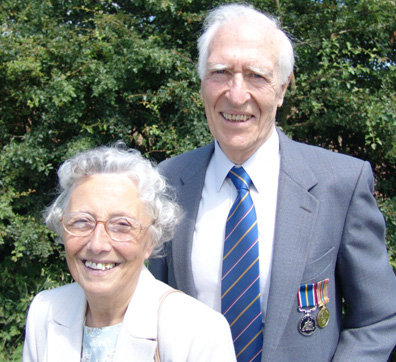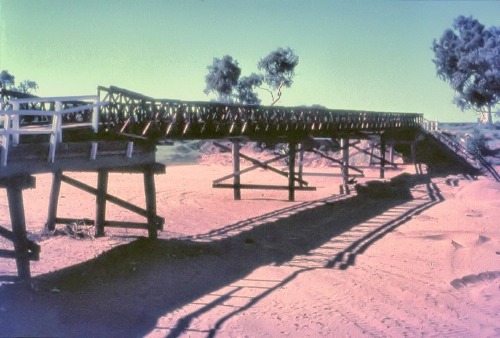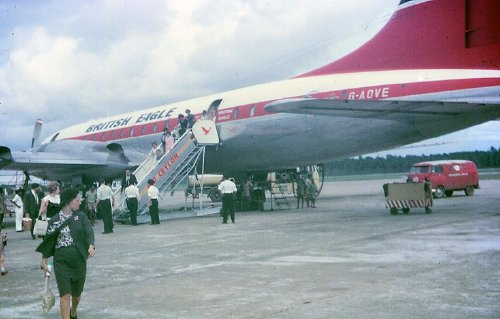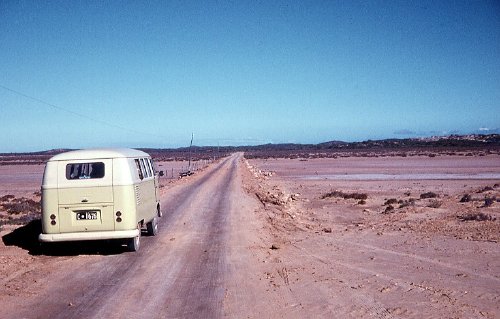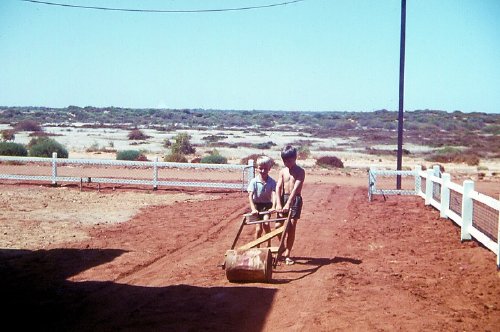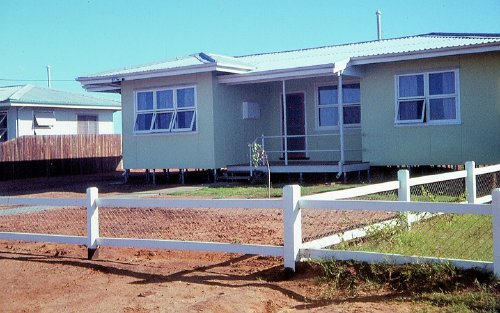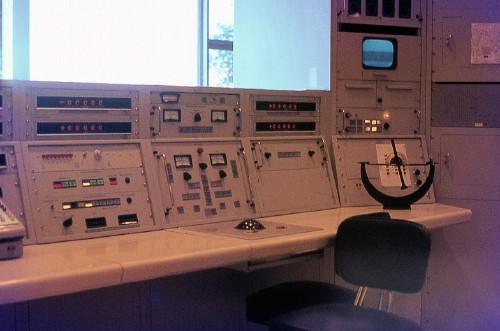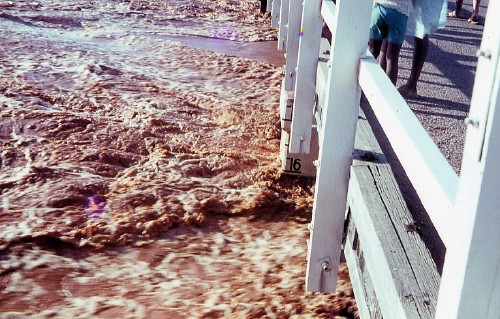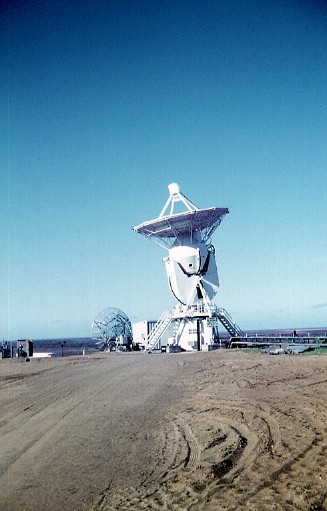|
Alan and Jean Gilham in 2005
Alan Gilham’s overview of his time with Amalgamated
Wireless (Australia) Ltd. –
In June 1965 together with Geoff Broom and Leo Overington we attended
a short course of lectures given by Dick Simons, Dave Brooks and Les Page
on the location and environment of Carnarvon WA.
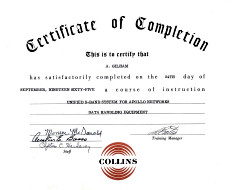 Next
stop was the Collins Radio factory in Dallas where we received instruction
on the USB system, on this course was Paul Dench, Monty Sala, John Fletcher,
Ben Ryan, Geoff Broom, Leo Overington, Dave Brooks, and of course myself
Alan Gilham. This was their first USB course. Next
stop was the Collins Radio factory in Dallas where we received instruction
on the USB system, on this course was Paul Dench, Monty Sala, John Fletcher,
Ben Ryan, Geoff Broom, Leo Overington, Dave Brooks, and of course myself
Alan Gilham. This was their first USB course.
We arrived in Carnarvon in early November 1965; my designated job was
Digital Engineer responsible for the maintenance and operations of the
Tracking Data Processor and the Antenna Position Programmer.
I left Carnarvon in late November 1967. |
Carnarvon, Western Australia 1965–67
by Alan Gilham
Entering the town of Carnarvon for the first time in early November 1965 was reminiscent of going into a film set of an early Western Movie, the red earth, the swing doors in the saloon and the verandas which adorned the Hotels and shops in the main street were redolent of that era, apart from the names over the shops like Wesfarmers, Dalgettys, Fitz’s Newsagents and Fongs.
The main street was incredibly wide to accommodate bullock carts and camel trains turning round when the bales of wool were transported to Geraldton by this method. The mature lady librarian, whose mother had lived outside Carnarvon all her life said that when it was proposed to include her mother’s name in a list of pioneers in the North West she had declined the honour saying “We weren’t isolated here as the camel trains came through every few weeks”.
We had just driven the 300 hundred mile from Geraldton along a recently graded and surfaced road, this work was paid for by NASA to enable easier access to the Tracking Station then being built on Brown’s Range, just outside Carnarvon, the road only had tarmac on a middle strip leaving sand and stones along the outer edges. These stones were an ever present danger when vehicles were passing as many a windshield was lost in that exercise, this gave rise to certain sections of the road being called the ‘Crystal Highway’.
There was an eighty mile stretch of the highway which was perfectly straight and monotonous to drive along and one had to be very alert to the dangers of falling asleep at the wheel. The only petrol station, called the Billabong, was situated halfway between Geraldton and Carnarvon. Just after the Billabong was a small faded sign saying Shark Bay was to the left. Seventy miles to the south of Carnarvon we had crossed over the dry river bed of the Wooramel, the wooden structure of this bridge was later washed away when Cyclone Elsie struck in 1967.
What were we doing in what the Australians then called ‘beyond the black stump’?
Well, in early 1965 I had answered an advert in the UK Electronics weekly asking for engineers and technicians to work at a NASA Tracking Station to be built in Carnarvon Western Australia. Being interested in the Space program and also having a very stressful job servicing the first generation of commercial computers to go on the market I decided to apply. I obtained a position as Digital Engineer working on the operation and maintenance of the tracking data processor and antenna positioning equipment on the newly designed Unified S Band equipment. This necessitated a trip to the States to attend a training course held at the Collins Radio factory in Dallas Texas. This was to be a three month course covering all aspects of the S Band system.
At the end of the course we paid a visit to the Greenbelt Maryland centre to see the operations there. During the time I spent in Dallas my wife took driving lessons so that when we arrived in Carnarvon she could use the car freely, this turned out to be a wise decision.
So having flown from UK to Perth (it took 37 hours flying time in those days) stopping at Kuwait, skirting the east coast of India – there was a war on at that time – and landing in Ceylon then on to Singapore.
Going into Singapore we encountered a tropical thunderstorm, the plane was thrown around violently. I spotted that the door seal had gone and that water vapour was entering the cabin. I then called the stewardess – who went as white as a sheet – who then called the flight engineer; they then spent the rest of the flight jamming a cot mattress around the door. After landing it took around six hours to get ready for the next leg of the flight to Perth. This last leg was a perfect flight; we flew down the coast line of Western Australia and could even see the dust trails made by the Gascoyne Traders trucks going up the Coastal Highway. We stayed in Perth whilst furniture and household effects were purchased for our new home in Carnarvon.
We called in at the Tracking Station in order to find out where we were going to be billeted, 4a West Street we were told, and off we went to locate the house. We had all the essentials already sent up from Perth, beds, table and chairs and a large refrigerator, our furniture and other personal effects shipped from the UK had arrived in a large crate which was unpacked later, it did not take long to settle in, make beds and a quick shopping excursion then blessed sleep.
|
Carnarvon Tracking Station |
Next morning, after breakfast we went on the porch and discovered a young kangaroo hopping around in the ‘garden’. This interested and pleased the boys somewhat. We set out to explore the town and to walk along the fascine, I was interested as to why the Fascine was so called but no one seemed to be able to tell me – but later digging into the origin showed that fascines were originally bundles of sticks tied together, hence the symbol of Fascism used by Mussolini. I presumed that bundles of sticks were put together to build the sea wall. It was possible to occasionally see sea snakes here in the water.
Wesfarmers was the only food shop in the town and the range of goods was initially very limited and sometimes one had to wait for the frozen milk to come on the Gascoyne Traders truck on the next weekly delivery. We eventually found that the powdered full cream milk made up and put in the fridge overnight was much more satisfactory than the blue tinged frozen variety. The bread – which was excellent – was provided by the local bakery with the delightful name of Memory and Shugg.
One of the first trips we made was to an area 40 miles to the north of Carnarvon known as the Blows. This was an area of soft rock where the sea had worn holes into its structure and the resulting effect of the waves was to produce plumes of water spectacularly into the air. There was an area of water protected by a reef in which one could bathe in comparative safety from sharks etc. We also went on the ‘road’ to Gascoyne Junction; this road ran alongside the dry river bed and the plantations, past the ten mile bridge. After about 20 miles of track we came to a pool in the river named ‘Chinamans Pool’. It was possible to swim safely in the shallow water.
Christmas 1965 was nearly upon us and we went to Geraldton to see what we could get for the boys’ presents. Geraldton suddenly appeared to be a very large town; it even had a set of traffic lights which was civilisation indeed. I had purchased a Volkswagen Combi in Perth to cope with boys and luggage on the way to Carnarvon, this proved a very good purchase as we were able carry all sorts of things to do the journey in relative comfort. Even in the high temperatures experienced in that part of WA the vehicle seemed to keep cool mainly due, I think, to the fact that there were no sloping areas of glass on the vehicle.
Christmas shopping over, the real work began at the Tracking Station; a commissioning crew came over from the States and work for me started in earnest. Meanwhile Jean (my wife) and the boys settled down to coping with their new environment. We invited two of the Americans to Christmas day dinner, cooking a turkey in temperatures of nearly 100 degrees was a bit exhausting but the meal was a success.
The house we were in suddenly turned into a disaster area, firstly, there were pigeons nesting in the roof space, I dislodged three nests by the simple expedient of sweeping them off the roofing boards into the garden, I think that this rather surprised the pigeons but it got them moved out. Secondly when turning the light on in the middle of the night we found that the kitchen was swarming with cockroaches. These were much more difficult to remove and eventually we moved to a newly built house on Babbage Island Road which was free of unwelcome guests. We had a large ‘huntsman’ spider which inhabited a space over the front door – I think he kept any insects away for a considerable time. This spider was not harmful, unlike the ‘redbacks’ which sometimes inhabited the mail box.
This house kept me busy in whatever spare time I had from the Tracking Station, the floors being made of Jarrah polished up wonderfully well. I had a load of clay soil dumped in the front of the house which we put over the sandy driveway in order to stabilise it. I borrowed an old roller made of an oil drum filled with concrete and together, myself and the boys with plenty of water sprinkled on the soil produced eventually a good solid surface.
After this I got water on the knee which was pretty painful, the doctor wanted to give me drugs to reduce it but I refused and I eventually found a cure – not recommended to everyone but it worked in my case. We were invited to a party during which I consumed large quantities of Port, this dehydrated me so much that the next morning the water had dispersed from my knee and I was back to normal.
The front and back areas of the house were nearly pure sand and, to try and give some semblance of a garden, I obtained some buffalo grass cuttings and some gum trees from the river bank. With frequent watering during the year we eventually had the sand covered with greenery.
Returning to see Carnarvon some 30 years later we found the gum trees were shading the front of the house – as I intended and the grass still green. The town had changed beyond belief, the verandas had gone and the main street had a central reservation, gone was the compacted red earth. The town had the appearance of a prosperous tourist location.
During this time work at the Tracking Station was proceeding and the systems were being put through their paces. When the night time winds were practically nonexistent then we would do ‘star tracks’ which consisted of pointing the antenna at known stars, passing the antenna positioning information to Houston enabling us to correct our angle displays and to verify our geographical location. Two films were made over this period, one by NASA and one by the Collins Radio personnel; we have only succeeded in locating excerpts from one of them.
The time came when the whole system needed to be tested. To do this NASA had several Super Constellation aircraft – known affectionately as ‘Connies’ – which were specially adapted to emulate the Apollo spacecraft. So our first task was to track the aircraft. We found that some information was not being downloaded correctly and I reversed a phase sensitive connection which cured the problem – silly me this action seemed to upset the engineer in charge and I had to explain – with drawings how a phase change occurred.
|
Super Constellation NASA 421 making a low pass over the Carnarvon Station at the end of the Apollo 17 sims, November 1972. Photo: Bob Burns.
|
We were now ready to do some serious work, one of the first tracks we undertook was to monitor the Saturn IVB booster rocket in Earth orbit to ascertain the fuel movement when a small ‘ullage’ rocket was fired, and this had the effect of moving the fuel toward the base ready to be reignited. The video obtained and later shown to us was very psychedelic to look at as the fuel moved in a weird motion.
When I was working outside on the antenna, helping to install some cooled parametric amplifiers I was on the hydraulic lift platform chatting with the native Australian who was operating the lift. He had, as I remember a colourful background, being brought up on a Mission Station inland, in a place called Meekatharra, had worked on sheep stations in the vicinity and having learned to drive, obtained a job at the Tracking station. The day was hot, sunny and windy and I found out to my cost the penalty of not wearing sun glasses as the next morning I awoke with eyes on fire and light was painful. Going to the doctor I found that I had severe conjunctivitis caused by fine sand, it was a condition locally known as ‘sandy blight’. It took several years to really get over it and, to this day, I use an eye wash every morning.
On the 14th February 1966 we had the upheaval of the currency changeover from the Pound to the Dollar; sensibly the 10 shilling was chosen to be base unit. When some time later the UK changed over to decimal currency the Pound was chosen as the base unit and the subsequent chaos and inflation that followed would have been avoided – in my estimation – if the ten shilling had been the base unit. By this time Jean had obtained a job in the high school as a clerical assistant.
On April 8th 1966 a Surveyor Model 2 was launched with the objective of simulating a highly eccentric lunar orbit. This was our first real track and we eagerly awaited the outcome, our antenna pointing data came from the FPQ6 system at that time as we did not have any tapes to program the USB equipment. This caused some inter rivalry between us and the FPQ6 team however when at about 25,000 nautical miles they lost radar contact and we proudly boasted that we still had contact and remained so until the Earth’s rotation caused us to lose signal.
The next day we tried to locate the spacecraft and discovered that without pointing data, locating the Moon was a long and tricky business. I obtained an Ephemeris in order to try and plot the Moon’s track, this worked alright when the Moon was just rising although I was always 4 minutes adrift. Afterwards I discovered that I had not compensated for the refraction of the Earth’s atmosphere. One of the team had a brilliant idea and constructed a device consisting of two school protractors and a pea shooter which gave the X and Y co-ordinates simply by looking at the Moon through the peashooter tube and taking the angles of the protractor. This earned us the jocular title of the ‘Moonrakers’.
We took a week’s leave and went to Perth, we put beds into the Combi and transferring the boys into them we were able to set out very early in the morning. As dawn was breaking we were greeted with the sight of a kangaroo hurtling its way on to the road at a great lick, I slowed down but the creature was still bounding along and just scraped the front bumper. We took many breaks on the way and nearing Perth we walked along the banks of the Murchison River – which still had water in it. Perth was and still is a very pleasant place to spend some time. King’s Park was an ideal place to wander around. My boys still remember the huge trunk of a Karri tree on display. Sadly this tree trunk deteriorated so much it was used as mulch.
Driving back to Carnarvon especially in the dark was fraught with problems of kangaroos and other nocturnal creatures crossing the road, there used to be a mob of kangaroos around the Wooramel and at other river crossings, sometimes I waited for a Gascoyne Trader truck to overtake and then follow as closely as I dared, keeping alert to dodge anything he struck – I should mention that the trucks had substantial ‘roo bars’ on the front.
In going to and from the Tracking Station we noticed that new houses were being built and a strange looking antenna was taking form, we later discovered that it was to do with satellite communication and was part of the Overseas Telecommunications Company (OTC). One day we had a visit from Kim Corcoran of the Australian Broadcasting Corporation who interviewed me and my wife; we didn’t know until later that we had been picked to be part of the first live TV broadcast between us and our families in the UK. The other people chosen were the Vinton family and the Brightwells, the Brightwells – if I remember correctly – owned the petrol station in town, the Vintons were, like us, a tracking station family.
The day of the transmission arrived (25th November 1966) and we assembled in the town centre waiting for the moment when contact was established. In the morning the town traffic was blocked off and the outside broadcast equipment was assembled and made ready, there was a temporary microwave link made between the town and the OTC Station and the Indian Ocean satellite.
The first interviews between the Brightwell and Vinton families went off exceedingly well but when it came to our turn I could not hear any reply and we just stumbled our way through the exchange. It wasn’t until about 40 years later when I obtained a copy of the transmission that I realised the satellite had drifted out of position and contact was lost for the period of our interview.
Prior to the TV broadcast there was a tropical carnival and some of the station staff made up a mock flying saucer and Saturn Rocket, it was quite a big event and we won a prize cup.
|
A flying saucer on wheels was the tracking station’s entry in the 1966 Tropical Festival. |
|
A Gascoyne Trading truck at the Tropical Festival. |
By now, at the Tracking Station we were keeping occupied by monitoring and tracking quite a number of spacecraft which were being launched in order to survey the Moon. They were the precursors of the Manned Lunar vehicles. Namely they were the Surveyor and Lunar Orbiters which were to survey and plan the actual landing sites. There were seven launches in 1966, three Surveyors, two Lunar Orbiters, one Explorer and one Pioneer. The Lunar Orbiter 2 was memorable as we worked two full weeks from moonrise to moonset – an enormous amount of data was sent to Houston over this period.
In between our tracking commitments there was very little to do and I was asked to take some visitors around the station, this relieved the monotony and I became the unofficial tour guide for the Station. I remember taking the Chamber of Commerce people from Perth around the site as well as Miss Australia 1966 and various tour parties and members of the Press. I must have posed for and had many pictures taken. One recently came to light extracted from the Walkabout Magazine for August 1967. How many more are there hidden away I ask myself?
|
| Alan – at right – is seated in this photo published in Walkabout magazine, August 1967. With thanks to Gordon Owttrim. See it in context here. |
Another Christmas was upon us, the town was by now gearing up to the fact that it was growing rapidly and we found it could supply its expanding population and there was no need for us to drive to Geraldton. There was a party held at one of the ‘trackers’ houses where we counted out the number of different nationalities in the room – we were surprised that we counted 14.
1967 arrived and we experienced our first Cyclone in the days around 21st January. We battened down everything and waited for it to unfold. The rain came and we collected it from the down pipes and made tea with it, it tasted delightful – our town water was pumped up from the river bed and always had a sandy earthy taste. The word went round that the Gascoyne River was in flood inland and we went to the Ten Mile Bridge to await its coming – and what a sight it was. There was a tidal wave of debris at its head followed by sandy coloured water. The water level at the bridge rose to nearly 16 feet and the flow was tremendous, the causeway to Babbage Island was inundated and some boys had to be rescued from the water. After the water subsided we were able to swim by the pumping station for many weeks until the water eventually disappeared.
We were called to do a simulation and communication exercise on the 27th January for Apollo 1. We had just completed our preliminary tests when I was informed that there had been an accident. A little later we were told to stand down and go home. I learned later that the Apollo capsule had caught on fire and the astronauts had perished. This event saddened us all. All further astronaut and capsule tests were suspended until further notice.
This event started me thinking about returning to UK as the future didn’t seem to hold its initial promise.
About this time I was asked to become the President of the local football federation, we had four football teams in the area mostly made up of people off the plantations. Keeping the peace between them was difficult because of the ingrained rivalries of the nationalities concerned. I held frequent meetings in the Gascoyne Hotel to help smooth things over.
There were several unmanned launches scheduled for 1967. The first being a Lunar Orbiter on the 5th February, there were no hitches on this track. When the next launch came along – a Surveyor on the 17th April – there was a departure from routine when the rocket was suddenly put into a lunar phase without first coming over Carnarvon – it being put into this phase when over Bermuda. There was an anxious wait and I calculated that we would see it over our Western horizon in about 10 – 15 minutes time, fortunately this turned out to be correct and I had a very relieved Station Director.
We took a two week break and went camping down in the South West, firstly staying in Perth for two or three nights.
During that time I booked our passage back to the UK on the Canberra leaving in late October. For me, the Apollo 1 fire and the subsequent delays in a manned launch plus the fact that my boys needed a better education than that available in Carnarvon was the reason for this decision. I also purchased a new camera which I used later to do some pictures of the people in the USB area.
Then we went off down south passing through places with delightful names like Bunbury, Busselton, and Margaret River and down to the Diamond Tree forest where I climbed the 200 ft tree which had the fire look-out on top – I think that they called it the Gloucester Tree. We spent a night in the Porongorups near to Castle Rock which we climbed the next day.
We looked in at Albany and then wended our way back to Perth and then the trek to Carnarvon. I should mention that to get from Perth to Carnarvon we had, in those days, to drive inland up the North West Highway through New Norcia, this was the only paved road at that time, then into Geraldton. Today there is the Brand Highway which runs up the Coast which makes it an easy drive.
Back at the Tracking Station there were a few more unmanned launches, a total of two more Lunar Orbiters, three Surveyors and a Mariner, the latter was for a Venus flyby. We began to prepare for our departure, when I spoke to the administration officer I found that they were prepared to give me some help with school fees if I wanted to send my boys to a boarding school in Perth – this was a very generous offer – but I had to decline it.
We packed, sold or gave away some of the things we had purchased whilst in WA and set off at the end of October 1967 back to UK.
The journey to Perth was uneventful save when we had a ‘comfort stop’ and found two 6ft red kangaroos watching us with interest.
We stayed in Perth for a couple of weeks to organise the finances – tax returns and such. In the bank we found an ex Carnarvon manager who gave us some sound advice, delaying the money transfer to UK until devaluation had taken place in the UK.
The journey on The Canberra was routine until we hit a Force 10 gale in the Southern Ocean. We called in at Durban and Cape Town spending enough time in them to take trips inland and see the sights, then it was Las Palmas and the UK and another period of upheaval till we finally settled down.
I took a job as a system engineer, my wife (Jean) went into teaching and the boys both obtained Honours Degrees in mathematics at Emmanuel College Cambridge. This period spent in Australia has a special place in our memory.
Alan Gilham
UK January 2008.
 Next
stop was the Collins Radio factory in Dallas where we received instruction
on the USB system, on this course was Paul Dench, Monty Sala, John Fletcher,
Ben Ryan, Geoff Broom, Leo Overington, Dave Brooks, and of course myself
Alan Gilham. This was their first USB course.
Next
stop was the Collins Radio factory in Dallas where we received instruction
on the USB system, on this course was Paul Dench, Monty Sala, John Fletcher,
Ben Ryan, Geoff Broom, Leo Overington, Dave Brooks, and of course myself
Alan Gilham. This was their first USB course.